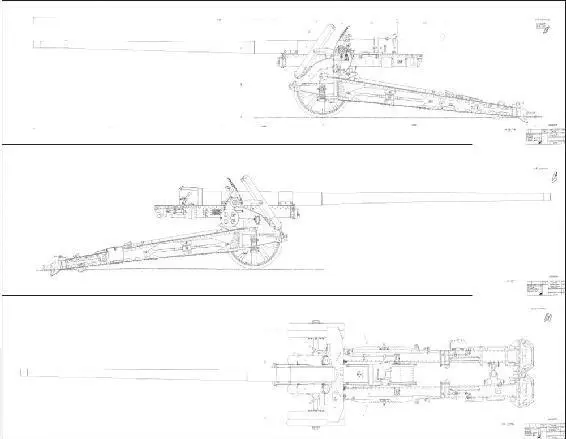
Factory drawings of M75 107 mm gun (TsAMO).
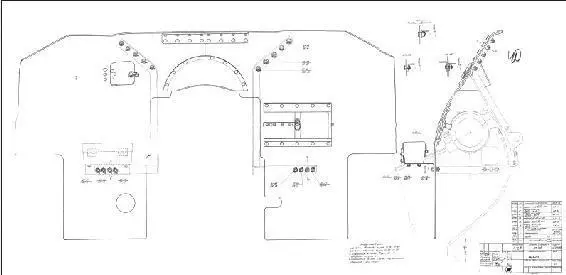
Factory drawing of gun shield for the M75 107 mm gun (TsAMO).
M75 involved mounting a 170 mm barrel 70 calibers in length on the carriage of the ML-20 152 mm gun-howitzer. This gun weighed an estimated 7.5–8 tonnes, which drastically limited its mobility on the battlefield. The main mission of this antitank monster was to fight the heavy and super-heavy tanks that intelligence received from spies indicated Germany was producing.
On May 22, 1941, a plenary session of the GAU’s Artillery Committee reviewed and approved a draft operational requirement for a “special-purpose 107 mm antitank gun and the ammunition for it.” The operational requirement called for a muzzle velocity of 1020 m/s and a capability to penetrate 160 mm of armor at a 30° angle of incidence from a range of 1000 meters. In addition, the gun was to be mounted on the carriage of the ML-20 152 mm gun-howitzer, which was clearly a plus for Factory No. 172. The length of the barrel was not to exceed 70 calibers, and it was to be capable of firing 10 rounds per minute. The system was estimated to weigh a total of 8000 kg.
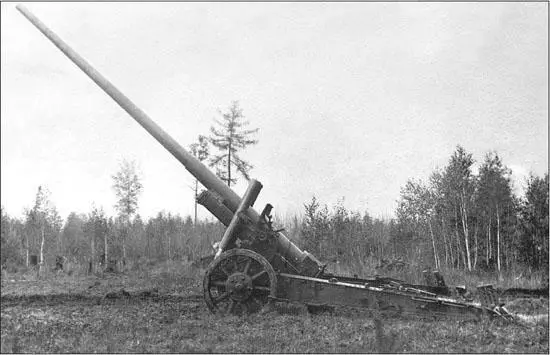
M75 107 mm antitank gun with barrel at maximum elevation (TsAMO).
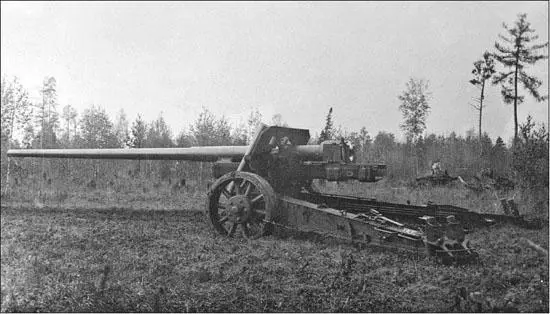
M75 107 mm antitank gun during testing (TsAMO).
No project to mount the 107 mm antitank gun on the KV chassis similar to the 212 or the SU-B-13 was in the works—not even at the operational requirement level. While the leaders were thinking up new types of weapons, the artillerymen were working on current projects. They completed the M75 prototype by July 1941, and the gun entered factory testing that same month. It should be noted that, unlike its counterparts, Factory No. 92’s design bureau had not progressed beyond design work in July because it was heavily engaged in other projects. Problems with manufacturing the required number of 107 mm shells and higher priority tasks made it necessary to temporarily scale back work on the heavy antitank gun.
M75 testing continued into 1942. By that time, however, there was no longer a need for the antitank monsters. The super-heavy German tanks had not materialized, and, in addition, the actual M75 parameters did not meet requirements for a variety of reasons. Work on the gun was put on hold, but it came up again in 1943 when the heavy German tanks eventually made it to the front.
In contrast to the 107 mm SP gun, the B-13 project with the 130 mm gun was listed in GAU development plans dated May 22, 1941. A proposal in 1941 called for production of 12 SP guns of that type, at a cost of 300,000 rubles each. The specifications for the SU-B-13 can be found both in a letter written by Kulik and in a draft operational requirement dated June 16, 1941:
I. General characteristics.
1. Vehicle type: tracked, armored
2. Total weight: 55 tons
3. Armament: the B-13 130 mm gun and 3 DT machine guns
4. Combat load: rounds for the gun, 100
- Machine-gun rounds: 2500
- Hand grenades: 30
5. Armor:
- Glacis: 30 mm
- Side: 30 mm
- Top: 30 mm
- Bottom: 20 mm
6. Crew: 7
7. All of the vehicle’s remaining dynamic characteristics and its mobility are to be the same as the KV-4 tank. The engine mount, transmission, and suspension system must be the same as those used on the KV-4.
8. The vehicle’s dimensions must allow shipment by rail.
9. SU-B-13 artillery system specifications:
a) The artillery system must be installed on a production chassis without a turret, and the crew must be protected against diving aircraft.
b) The angle of traverse must be at least +/-10°.
Elevation +20° to 25°
-2° to -3°
c) The layout of the artillery system, aiming devices, and ammunition rack must enable at least three aimed shots per minute.
d) The vision devices must provide good visibility from the vehicle, and a commander’s cupola enabling 360° vision must be installed.
e) The vehicle must support firing from cover.
f) The artillery system must have a means of securing the gun in travel position.
10. Communications equipment:
a) A KRSTB radio must be provided for external communication. A TPU-4 intercom system must be installed for internal communication.
b) Provide for stowage of 2 telephone sets and 2–3 km of wire. {10} 10 TsAMO RF, collection 38, series 11355, file No. 6, pp. 142–143.

M75 107 mm antitank gun. Unlike the ML20 and A-19, this gun had a sliding wedge breechblock (TsAMO).
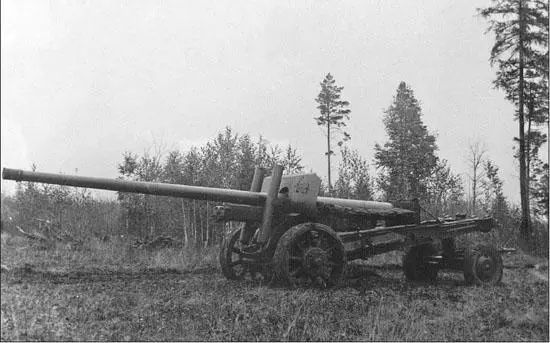
M75 107 mm antitank gun in travel position (TsAMO).
Unlike the 212, the SU-B-13 was not a bunker buster. The specifications clearly describe a heavy tank destroyer that was developed in a rush to combat German heavy and super-heavy tanks. This is clearly evident from the rate-of-fire requirement and the requirement for 30 mm of armor, the same armor thickness as on the SU-34 tank destroyer based on the T-34 and the A-46 tank destroyer based on the A-42 prime mover, which were developed by Kalinin Factory No. 8 (in Kaliningrad, a city now named Korolev). The identification of the KV-4 as the base chassis is an error. Records show that this is what Kulik called the KV-3 (Project 223), confusing it with the KV-3 (Project 150, or the T-150), which originally was supposed to go into production. Because the Great Patriotic War began a week after the operational requirement was drafted, the SU-B-13 did not make it past the conceptual design stage.
CHAPTER 3.
The Evacuation
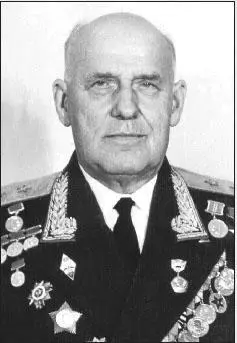
F. F. Petrov, developer of many famous towed, tank, and self-propelled artillery pieces (V. Len).
The tank programs underwent a fundamental revision immediately after Germany attacked the Soviet Union. The manufacture of armored vehicles already in production was accelerated, and programs that were in the design stage or that did not conform to wartime realities were shut down. The most common theory has it that Project 212 met a similar fate, but its actual history was somewhat different.
Under Order No. 253ss issued by the People’s Commissariat of Heavy Machine Building on June 26, 1941, preparations for production of the KV-3 were transferred from the Kirov Factory to the Chelyabinsk Tractor Factory (ChTZ). Chelyabinsk received a team of designers from the Kirov Factory, as well as production engineers, materials, and the KV-3 prototype minus its turret and a number of other assemblies. As of February 1942, this KV-3 was located in experimental shop OP-2. But Project 212 continued to be listed as a Kirov Factory project until early August 1941, as evidenced by a letter GAU Deputy Director Lt. Gen. V. I. Khokhlov wrote on the 11th to V. A. Malyshev, People’s Commissar of Medium Machine Building:
Читать дальше



















